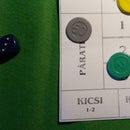Introduction: Live Coals on the Top of the Bookshelf - an Easy Mood Lamp
I like the warm light, like the fireplace, or other fire-like lights. And there is a very easy way to reproduce this with classical light bulbs, but this is used very rarely as I know. You don't need any special electric part for it, just some bulbs in sockets and some wire. And - in this energy-saving world - a plus mentionable pro of it is the very low consumption; but, to tell the truth I must mention that, this usage of the bulbs doesn't give too much lights - but this fire-like and dim light is ideal for those DIY-fellows who want to build a real mood lamp. Not more, just a mood lamp...
I made it with 6 bulbs in one row, and put it onto my large bookshelf on its top, under the ceiling. The white ceiling reflects the orange fire-like light down, and gives a very friendly, dim glowing around. If you have any other idea of the placing, you may arrange the bulbs in circle or in a spot, or anyhow. My linear arrangement is for the 2 m long shelftop.
Step 1: Materials and Tools
What you need
- 6 pcs of bulbs with their sockets (with the SAME wattage, I recommend 60 watts, the smaller wattage is too dim, but you can try, if you want.)
- some well insulated wire as long as you need to place the bulbs on a lamp body. I used 4 meters for wiring, and about 3 meters to plug it into the wall socket. (The wiring from the wall to lamp body, and the switch is not part of this instructable, I'd like only explain the body and the bulbs wiring itself as a lamp that you put and build into where you want.)
- a terminal with 2 poles
- a cable with switch and plug for the wall plug, as mentioned. Its lenght is optional, you should know, where to plug it when ready.
- an 'L'-shaped slat for the body (I used 2 meters long, because the shelftop is 2 m.)
- screws for wood - some kind of varnish or polish material - I used water basis varnish and a light brown wood-polish.
What you will work with:
- a pencil to mark
- a ruler to measure
- a cutter to cut the wire
- a drill to make holes
- a screwdriver to drive screws into the sockets and the wooden body when assembling
- paint brush to maintain the surface
- and AT LEAST A MINIMAL SKILL IN THE ELECTRICAL WORKS, BECAUSE THE WALL SOCKET VOLTAGE IS DANGEROUS! THE WALL SOCKET VOLTAGE IS HIGH (110 OR 230 V), WHICH MAY CAUSE DEADLY ELECTRIC SHOCK! DO NOT START TO BUILD THIS LAMP, IF YOU ARE NOT FAMILIAR WITH THE BASICS OF THE PROTECTION OF ELECTRIC SHOCK AND THE ELECTRIC INSULATION, OR HOW TO AVOID ACCIDENTS THE HIGH VOLTAGE MAY CAUSE! IF YOU THINK YOU AREN'T SKILLED ENOUGH IN ELECTRICITY DON'T TRY TO BUILD THIS LAMP, OR ASK AN EXPERT TO HELP YOU! I REJECT ANY RESPONSIBILITY OF ANY ACCIDENT DURING THE BUILDING OR USING THIS LAMP!
And now let's begin!
Step 2: Plans, Schematics, and Some Math...
First make a plan. The schematic is seen here.
The wiring plan is a 'serial circut', where the main voltage is divided as parts as many bulbs you connect into the circle. So that, the resistance will added together, the current will be decreased, and so the wattage on the bulbs will be lower than normally (less current, less voltage - more less wattage). And, for this reason, the light of the bulbs will be dim, orange and fire-like.
If you want to do a little math: at 3 same bulbs in serial circuit the wattage you get will get on the bulbs is 1/9 of the normal wattage of the same bulb. Now we have 3 bulbs in one row, this is 3/9 of the wattage of ONE bulb, or 1/3, or numerally 20 watts for the whole system. But we connect TWO serial circuits, like this, paralelly to each other for the 6 bulbs system, which will double the consumption, and the light, of course - so the final wattage will be cca 40 watts in the whole system, instead of the normal 6×60=360 watts (if you connected them all into the classic paralel circuit). I hope this is correct:-)
Step 3: Wooden Works
So. Since the plans are ready, buy a slat, if you can, an 'L'-shaped to get a front side automatically. Behind its front face will stand the sockets with the bulbs. Varnish (or not) it, ad libitum,and measure the places of the bulbs. If you use more than 3 bulbs in one serial circuit, the amount of the light will be too little, if less (2 per circuits), the bulbs will produce almost as light as normally. But be creative, unless you connect something into a wrong place, the system will work.
When measured and marked, drill the holes. I used a small instrument to deep the holes to fit the head of the screws. With this small thing (I don't know what its name is) you can avoid the tilting of the lamp when a screw is in.
Step 4: Connections
After this, cut the wires, and create the connections of the whole circuit, referring the schematics and the images. The terminal connects to the 'main' poles of the circuit, because the system is a lamp only until this point; after it the cable with a switch and the wall plug is a moveable, other part (and I won't speak about it in this short instructable, everybody can form it after its own needings).But avoid the weak connections, strenghten firmly all them.
And again: IF YOU THINK YOU AREN'T SKILLED ENOUGH IN ELECTRICITY, DON'T TRY THIS STEP ALONE YOURSELF, ASK AN EXPERT TO HELP YOU!
And this is the moment when you can try the system, too. Put the bulbs into the sockets, plug the system in, and admire the colour of the bulbs:-) If you are satisfied, go the next step.
Step 5: Finishing
When ready, you will have to build the body and the sockets together with the screws. This step depends on a lot of things, the type of the socket, the material of it, if it has holes on the bottom, etc. Be creative, and try to fix it behind the front of the body. Your last chance may be a glue gun, but this method is not too elegant...
Finally take the cable with the switch and plug and connect it to the terminal. And now... screw the bulbs into their sockets, and put the lamp to its final place. You are ready. Wait for the evening, and switch off the lights, except this. Call your girlfriend (or wife), and enjoy the romantic mood light (or make plans for a robbery, count your money you get from a blackmail, carve a gun from a soap, or... anything. But do enjoy it:-))













